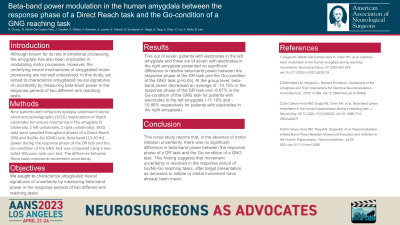Beta-band power modulation in the human amygdala between the response phase of a Direct Reach task and the Go-condition of a Go/No-Go reaching task
Beta-band Power Modulation in the Human Amygdala Between the Response Phase of a Direct Reach Task and the Go-condition of a Go/no-go Reaching Task
Friday, April 21, 2023


Ryan S. Chung, BA (he/him/his)
Medical Student
Keck School of Medicine USC
ePoster Presenter(s)
Introduction: Although known for its role in emotional processing, the amygdala has also been implicated in modulating motor processes. However, the underlying neural mechanisms of amygdaloid motor processing are not well understood. In this study, we aimed to characterize amygdaloid neural signatures of uncertainty by measuring beta-band power in the response periods of two different arm reaching tasks.
Methods: Nine patients with refractory epilepsy underwent stereo electroencephalographic (SEEG) implantation of depth electrodes for seizure monitoring in the amygdala (5 bilaterally, 2 left unilaterally, 2 right unilaterally). SEEG data were sampled throughout phases of a Direct Reach (DR) and Go/No-Go (GNG) task. Beta-band (13-30 Hz) power during the response phase of the DR task and the Go-condition of the GNG Task was compared using a two-tailed Wilcoxon rank sum test. The difference between these tasks represents movement uncertainty.
Results: Five out of seven patients with electrodes in the left amygdala and three out of seven with electrodes in the right amygdala presented no significant difference in relative beta-band power between the response phase of the DR task and the Go-condition of the GNG task (p>0.05). At the group level, beta-band power decreased an average of -10.15% in the response phase of the DR task and -8.67% in the Go-condition of the GNG task for patients with electrodes in the left amygdala (-11.19% and -10.86% respectively for patients with electrodes in the right amygdala).
Conclusion : This novel study reports that, in the absence of motor initiation uncertainty, there was no significant difference in beta-band power between the response phase of a DR task and the Go-condition of a GNG task. This finding suggests that movement uncertainty is resolved in the response period of Go/No-Go reaching tasks, after target presentation, as decisions to initiate or inhibit movement have already been made.
Methods: Nine patients with refractory epilepsy underwent stereo electroencephalographic (SEEG) implantation of depth electrodes for seizure monitoring in the amygdala (5 bilaterally, 2 left unilaterally, 2 right unilaterally). SEEG data were sampled throughout phases of a Direct Reach (DR) and Go/No-Go (GNG) task. Beta-band (13-30 Hz) power during the response phase of the DR task and the Go-condition of the GNG Task was compared using a two-tailed Wilcoxon rank sum test. The difference between these tasks represents movement uncertainty.
Results: Five out of seven patients with electrodes in the left amygdala and three out of seven with electrodes in the right amygdala presented no significant difference in relative beta-band power between the response phase of the DR task and the Go-condition of the GNG task (p>0.05). At the group level, beta-band power decreased an average of -10.15% in the response phase of the DR task and -8.67% in the Go-condition of the GNG task for patients with electrodes in the left amygdala (-11.19% and -10.86% respectively for patients with electrodes in the right amygdala).
Conclusion : This novel study reports that, in the absence of motor initiation uncertainty, there was no significant difference in beta-band power between the response phase of a DR task and the Go-condition of a GNG task. This finding suggests that movement uncertainty is resolved in the response period of Go/No-Go reaching tasks, after target presentation, as decisions to initiate or inhibit movement have already been made.
